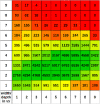Axial Stretching of Vessels in the Retinal Vascular Plexus With 3D OCT-Angiography
- PMID: 35147662
- PMCID: PMC8844947
- DOI: 10.1167/tvst.11.2.21
Axial Stretching of Vessels in the Retinal Vascular Plexus With 3D OCT-Angiography
Abstract
Purpose: The purpose of this study is to describe and quantify the nonpathological axial stretching in the retinal vascular plexus in three-dimensional (3D) optical coherence tomography angiography (OCTA) images.
Methods: The 3D vascular network underneath the inner limiting membrane of OCTA volumes was labeled as ground truth (GT) data. To analyze the cross-section area of the vessels the width and depth of the vessels in the GT data were computed and an elliptical quotient was proposed to quantify the axial stretching.
Results: A total of 21 3D OCTA volumes were labeled. It was found that the vessels in 3D OCTA images are stretched in the direction of the A-Scan by a factor of 2.46 ± 1.82 with a median of 2.24. Furthermore, a larger cross-section area leads to higher axial stretching.
Conclusions: The elliptical shape of the cross-section area of the vessel does not match with the expected pathology of the vascular network in the human eye. Therefore a correction of the volume data before a 3D analysis is recommended.
Translational relevance: This work gives a systematic insight to the stretched shape of vessels in 3D OCTA images and is relevant for further clinical research analyzing the 3D vascular network.
Conflict of interest statement
Disclosure:
Figures







References
-
- El-Baz A, Jiang X, Suri JS, eds. Biomedical Image Segmentation: Advances and Trends. Boca Raton: CRC Press, 2016.
-
- Eladawi N, Elmogy M, Ghazal M, et al. .. Early signs detection of diabetic retinopathy using optical coherence tomography angiography scans based on 3D multi-path convolutional neural network. In: 2019 IEEE International Conference on Image Processing (ICIP). 2019: 1390–1394.
-
- Ma Y, Hao H, Xie J, et al. .. ROSE: A retinal OCT-angiography vessel segmentation dataset and new model. IEEE Transactions on Medical Imaging. 2021; 40: 928–939. - PubMed
Publication types
MeSH terms
LinkOut - more resources
Full Text Sources
Miscellaneous

